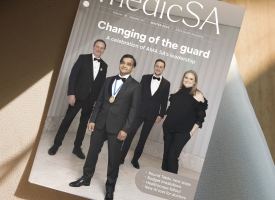AMA Submission to the Senate Community Affairs Legislation Committee inquiry into Aged Care (Living Longer Living Better) Bill 2013 and related bills
The Bills are about bricks and mortar. While the Bills create a framework for providing aged care subsidies, they make no provision to secure medical and nursing care for older Australians by integrating clinical care into the aged care services. The complexity of multi-system medical disorders that afflict older people warrant the regular attention of medical practitioners and quality nursing care, which in turn warrants consideration in the context of aged care reforms.
Medical Care in Residential Aged Care Facilities
- Poor access to properly equipped clinical treating rooms which limits the medical treatment that can be provided in that setting;
- An absence of information technology infrastructure to facilitate access to electronic patient records and medication management, including software appropriate to the needs of general practitioners (GPs) and improved electronic interface between pharmacy services and RACFs records;
- A strong financial disincentive for the medical practitioners to leave their surgery, with all its attendant costs, to provide services in RACF;
- A growing tendency to build RACF in the outer growth corridors or ‘urban fringe’ of metropolitan areas which further adds to the time spent by medical practitioners away from their surgeries;
- A lack of access to registered nurses with whom to co-ordinate care. Nursing services are provided in a variety of ways, some of which impact negatively on the timeliness and quality of care; and
- An increasing use by RACF of agency staff who are not familiar with residents which compromises continuity of care.
The Australian Nursing Federation “7 Reasons Why Aged Care Can’t Wait” campaign highlights the critical shortage of nurses in aged care.
Medical Care in the Community
However, current Medicare benefit arrangements do not reflect the time it takes to provide care to older people with chronic long-term conditions and do not cover the costs of delivering medical care outside of the GPs surgery. As a result, home visits no longer feature in GP care as much as they once did. As older people seek to live independently in their own homes rather than move into RACFs, there will need to be greater support for providing medical care in the community setting. Provision must be made for adequate nursing and allied health services to support the medical workforce to provide medical care to older Australians living at home and in RACFs.
The current aged care assessment arrangements fall short on efficiency and responsiveness to the care needs of older people. The effectiveness of the aged care assessment process can be improved by including the patient’s usual medical practitioner in the assessment arrangements. Our members tell us aged care assessment currently makes little use of the information doctors can provide about their patients. Medical practitioners form long-term relationships with their patients. An older person’s usual doctor, be they a general practitioner or geriatrician can bring his or her background knowledge of the whole person and their current circumstances to the assessment process. This information would ensure the person’s assessment results in them receiving the care that is most appropriate for them, be it in the community or RACF. It would also reduce the assessment time, which would allow people to access services more quickly.
Respite Care
Approval for respite care depends on a formal Aged Care Assessment Team (ACAT) assessment. In some jurisdictions, difficulty in accessing an ACAT assessment means it can take months before approval for respite care is given. In the meantime, sometimes the only option is to admit the patient to hospital in order to give the carer some relief. This causes great distress for patients and their carers and the risk of delivering respite care that is inappropriate both in timing and in the nature of the care given.
The Minister for Mental Health and Ageing, Mark Butler, declined an AMA proposal to convene a group of medical and nursing experts to provide him with specific advice on how to ensure medical and nursing care for older Australians who cannot make the trip to the surgeries and clinics where these services are provided. These are not matters to be left to the Medical Benefits Division of the Department of Health and Ageing to resolve. They require proper consideration in the context of aged care services.
The AMA recommends the Committee consider amendments to the Aged Care (Living Longer Living Better) Bill 2013 to:
- Establish a Ministerial Clinical Advisory Committee; and
- Include in subclause 4(2) that the review of the operations of amendments consider the extent to which medical and nursing services are integrated into aged care services.
April 2013



